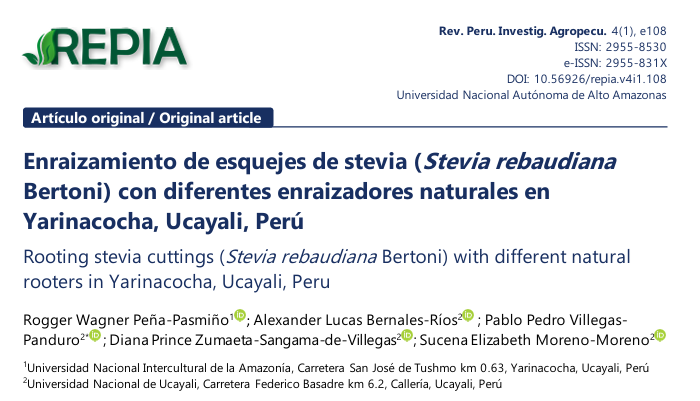Rooting stevia cuttings (Stevia rebaudiana Bertoni) with different natural rooters in Yarinacocha, Ucayali, Peru
DOI:
https://doi.org/10.56926/repia.v4i1.108Keywords:
biorooters, rooting, herbaceous cuttings, vegetative propagation, steviaAbstract
The objective was to evaluate the rooting of stevia (Stevia rebaudiana Bertoni) cuttings using natural rooting agents in Yarinacocha, Ucayali, developed at the Instituto Superior Pedagógico Bilingüe de Yarinacocha. The cuttings, 10 cm long, were collected in the morning from plants that had been previously grown in an aquaponic system. A subirrigation chamber was built using materials such as wood and polyethene mica, stone, gravel, and sand were used as an inert substrate. The cuttings, treated with different rooting agents, were placed in this chamber: Rootone, aloe, coconut water, and lentil water. The experiment was evaluated 60 days after installation, analyzing variables related to the development of the cuttings. A Completely Randomized Design was used with four treatments and twenty replications. Tukey's test of averages with a significance level of α = 0.05. The results show that lentil water treatment was the most effective, achieving 61% rooting, as well as the best averages in stem length, number of leaves, number of shoots, root length and number of roots, presenting significant differences with respect to the other treatments, concluding that lentil water is an effective and natural alternative for the rooting of stevia cuttings.
Downloads
References
Borges, J. A., León, M., Marturet, E., & Barrios, M. (2016). Fitoestimulación en estacas de morera (Morus alba L.) mediante extractos vegetales. Bioagro, 28(3), 215-219.
Córdova Ruiz, R. E. (2019). Aplicación de extractos vegetales en la propagación asexual de estacas de valeriana (Valeriana sp.). Tesis para obtener el grado de Ingeniera Agrónoma. Universidad Técnica de Ambato. Facultad de Ciencias Agropecuarias. Carrera De Ingeniería Agronómica. Ambato – Ecuador.
Cruz Chavez, D., & Bosque Sánchez, H. D. (2021). Evaluación del efecto de tres enraizadores naturales en la propagación vegetativa de la kiswara (Buddleja incana Ruíz y Pav.) en el Centro Experimental Cota Cota. Tesis para optar el título de Ingeniero Agrónomo. Universidad Mayor de San Andrés. Facultad de Agronomía. Disponible en: http://repositorio.umsa.bo/xmlui/handle/123456789/27517
Fernández, O. (2012). Propagación in vitro de Stevia rebaudiana Bertoni a través de embriogénesis somática. Universidad de Antioquia. Recuperado de https://bibliotecadigital.udea.edu.co/dspace/bitstream/10495/11303/1/FernandezOsman_2012_PropagacioninvitroSteviarebaudianaEmbriogenesis.pdf
García, D., & Medina, E. (2014). Uso de bioestimulantes naturales en la agricultura ecológica: extracto de lentejas como fuente de auxinas. Revista Agroecología, 9(2), 45-52.
García Cid, F. E., Tapia Zayago, F. A., Pérez Ríos, S. R., Madariaga Navarrete, A., de Jesús Cenobio Galindo, A., & Soto, I. H. (2024). Enraizantes a base de lenteja y sábila una alternativa ecológica en la producción de tomate. Boletín de Ciencias Agropecuarias del ICAP, 10(20), 10-15. DOI: https://doi.org/10.29057/icap.v10i20.12371
Garces, R. V., & Medrano, N. C. (2024). Efecto de tres dosis de bioestimulante con dos tipos de sustrato en la propagación asexual de estacas de pitahaya roja (Hylocereus hybridum), bajo condiciones de invernadero, Independencia–Huaraz-Ancash. Aporte Santiaguino, 17(1), ág-69. DOI: https://doi.org/10.32911/as.2024.v17.n1.1140
Goyal, S. K., Samsher, & Goyal, R. K. (2010). Stevia (Stevia rebaudiana) a bio-sweetener: A review. International Journal of Food Sciences and Nutrition, 61(1), 1-10. https://doi.org/10.3109/09637480903193007 DOI: https://doi.org/10.3109/09637480903193049
Hargreaves, J. C., Adl, M. S., & Warman, P. R. (2009). The effects of municipal solid waste compost and compost tea on mineral element uptake and fruit quality of strawberries. Compost Science & Utilization, 17(2), 85-94. DOI: https://doi.org/10.1080/1065657X.2009.10702406
Hartmann, H. T., Kester, D. E., Davies, F. T., & Geneve, R. L. (2011). Plant Propagation: Principles and Practices (8.ª ed.). Prentice Hall.
López Medina, S. E., Gil Rivero, A. E., & López Zavaleta, A. (2018). Enraizamiento de esquejes de Stevia rebaudiana Bertoni (Asteraceae) "estevia", aplicando dosis crecientes de ácido indolbutírico. Engormix. Recuperado de https://www.engormix.com/agricultura/azucares-naturales/enraizamiento-esquejes-stevia-rebaudiana_a41769/
López Medina, S. E., Gil Rivero, A. E., & López Zavaleta, A. (2016). Enraizamiento de esquejes de Stevia rebaudiana Bertoni (Asteraceae) "estevia", aplicando dosis crecientes de ácido indolbutírico. Arnaldoa, 23(2), 467-478. Recuperado de https://journal.upao.edu.pe/Arnaldoa/article/view/672 DOI: https://doi.org/10.22497/arnaldoa.232.23209
López Medina, E., López Zavaleta, A., & De la Cruz Castillo, A. (2017). Efecto del ácido giberélico en la propagación in vitro de Stevia rebaudiana (Bertoni) Bertoni," estevia". Arnaldoa, 24(2), 599-608. http://dx.doi.org/10.22497/arnaldoa.242.24211 DOI: https://doi.org/10.22497/arnaldoa.242.24211
Mamani, E. T. (2024). Propagación de estacas de higo (Ficus carica L.) bajo enraizadores naturales en distintos tiempos de sumersión. Revista de Investigación e Innovación Agropecuaria y de Recursos Naturales, 11(1), 47-56. DOI: https://doi.org/10.53287/zecr7375iw83w
Naik, B. H., & Chand, P. K. (2006). High frequency axillary shoot regeneration and plantlet formation from nodal explants of Pogostemon cablin (Blanco) Benth. using thidiazuron and coconut milk. Scientia Horticulturae, 108(1), 32-37.
Oviedo Pereira, D., Alvarenga, S., Evangelista, S., Sepúlveda, G., & Rodríguez Monroy, M. (2015). Micropropagación de Stevia rebaudiana Bertoni, un cultivo promisorio para México. BioTecnología, 19(2), 14-27.
Paredes-Suárez, P. D. C., Bautista-Gálvez, A., Ortega-Ramírez, M. E., Jiménez-Vera, R., Benítez-Mandujano, M., & González-Cortés, N. (2021). Enraizamiento de mini esquejes de Stevia rebaudiana Bertoni con ácido indolbutírico en hidroponía. Revista Fitotecnia Mexicana, 44(3), 367-372. Recuperado de https://www.scielo.org.mx/scielo.php?pid=S0187-73802021000300367&script=sci_arttext DOI: https://doi.org/10.35196/rfm.2021.3.367
Pérez, L. M., & Cid, L. P. (2016). Estrategia para la propagación in vitro de Stevia rebaudiana Bertoni. Biotecnología Vegetal, 16(3), 187-194. Recuperado de https://biblat.unam.mx/hevila/Biotecnologiavegetal/2016/vol16/no3/1.pdf
Peteliuk, V., Rybchuk, L., Bayliak, M., Storey, K. B., & Lushchak, O. (2021). Natural sweetener Stevia rebaudiana: Functionalities, health benefits and potential risks. EXCLI Journal, 20, 1412–1430. https://doi.org/10.17179/excli2021-4211
Quezada Nieves, F. E. (2011). Propagación por esquejes de stevia (Stevia rebaudiana Bert) en tres sustratos y dos dosis de hormona de enraizamiento bajo invernadero en el Cantón Santa Isabell. Tesis para optar el título de Ingeniero Agrónomo. Universidad de Cuenca. Facultad de Ciencias Agropecuarias. Cuenca, Ecuador. Disponible en: https://dspace.ucuenca.edu.ec/items/1042f78d-59e9-42ca-bc77-5dd8d78d8500
Rodríguez García, T. (2013). Evaluación de enraizadores de esquejes en la propagación de Stevia rebaudiana Bertoni en la localidad de Roma – La Libertad. [Tesis de licenciatura, Universidad Nacional de Trujillo]. Repositorio Institucional de la Universidad Nacional de Trujillo. Recuperado de https://dspace.unitru.edu.pe/items/0d2f5959-6926-4792-a4f1-d22550e413f3
Sánchez Condori, L. (2023). Efecto de cinco enraizadores naturales en la propagación asexual de yuca (Manihot esculenta Crantz). Tesis para optar el título de Ingeniero Agrónomo. Universidad Nacional Daniel Alcides Carrión. Facultad de Ciencias Agropecuarias. Disponible en: http://repositorio.undac.edu.pe/handle/undac/3296
Suárez Padrón, I. E., & Salgado, J. A. (2008). Propagación in vitro de Stevia rebaudiana Bert. (Asteraceae-Eupatorieae) a través de organogénesis. Temas Agrarios, 13(1), 40-47. Recuperado de https://www.researchgate.net/profile/Isidro-Suarez/publication/324229753_Propagacion_in_vitro_de_Stevia_rebaudiana_Bert_Asteraceae-Eupatorieae_a_traves_de_organogenesis/links/545791670cf26d5090ab2424/Propagacion-in-vitro-de-Stevia-rebaudiana-Bert-Asteraceae-Eupatorieae-a-traves-de-organogenesis.pdf DOI: https://doi.org/10.21897/rta.v13i1.663
Ticona Medina, E. S., & Orzag Cespedes, V. (2022). Evaluación del enraizamiento de saúco (Sambucus nigra L.) bajo el uso de enraizadores naturales para la producción de plantines en el Centro Experimental Cota Cota. Tesis para optar el título de Ingeniero Agrónomo. Universidad Mayor de San Andrés. Facultad de Agronomía. Disponible en: http://repositorio.umsa.bo/xmlui/handle/123456789/29732
Zhang, X., & Ervin, E. H. (2004). Cytokinin-containing seaweed and humic acid extracts associated with creeping bentgrass leaf cytokinins and drought resistance. Crop Science, 44(5), 1737-1745. DOI: https://doi.org/10.2135/cropsci2004.1737

Downloads
Published
How to Cite
Issue
Section
License
Copyright (c) 2025 Rogger Wagner Peña-Pasmiño, Alexander Lucas Bernales-Ríos, Pablo Pedro Villegas-Panduro, Diana Prince Zumaeta-Sangama-de-Villegas, Sucena Elizabeth Moreno-Moreno

This work is licensed under a Creative Commons Attribution 4.0 International License.
Authors retain their rights:
a. The authors retain the intellectual property rights (copyright) of the published works, assigning to the journal the right of first publication.
b. Authors retain their trademark and patent rights, and also on any process or procedure described in the article.
c. Authors retain the right to share, copy, distribute, perform and publicly communicate the article published in REPIA (e.g., place it in an institutional repository or publish it in a book), with an acknowledgement of its initial publication in REPIA.
d. Authors retain the right to make a subsequent publication of their work, to use the article or any part of it (e.g., a compilation of their work, notes for conferences, theses, or for a book), provided they indicate the source of publication (authors of the work, journal, volume, number, and date).







